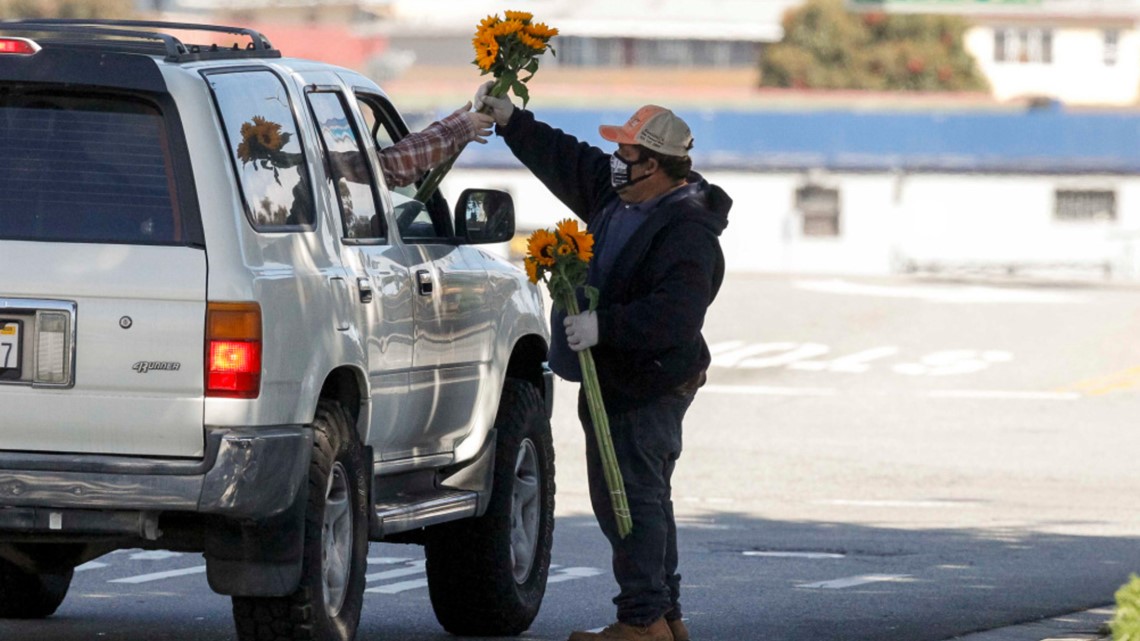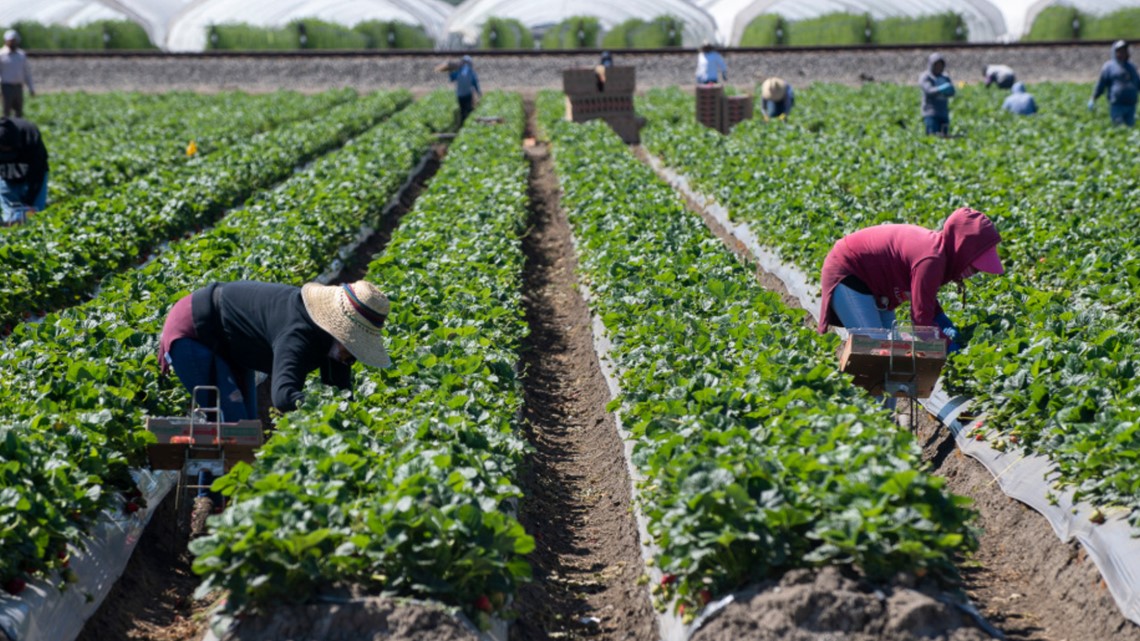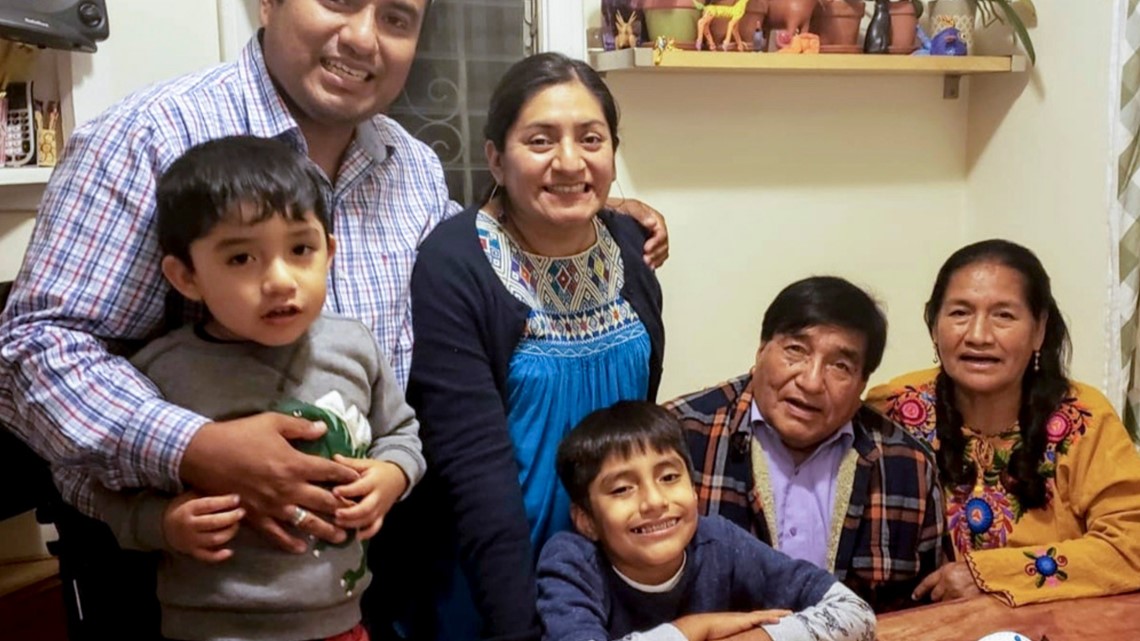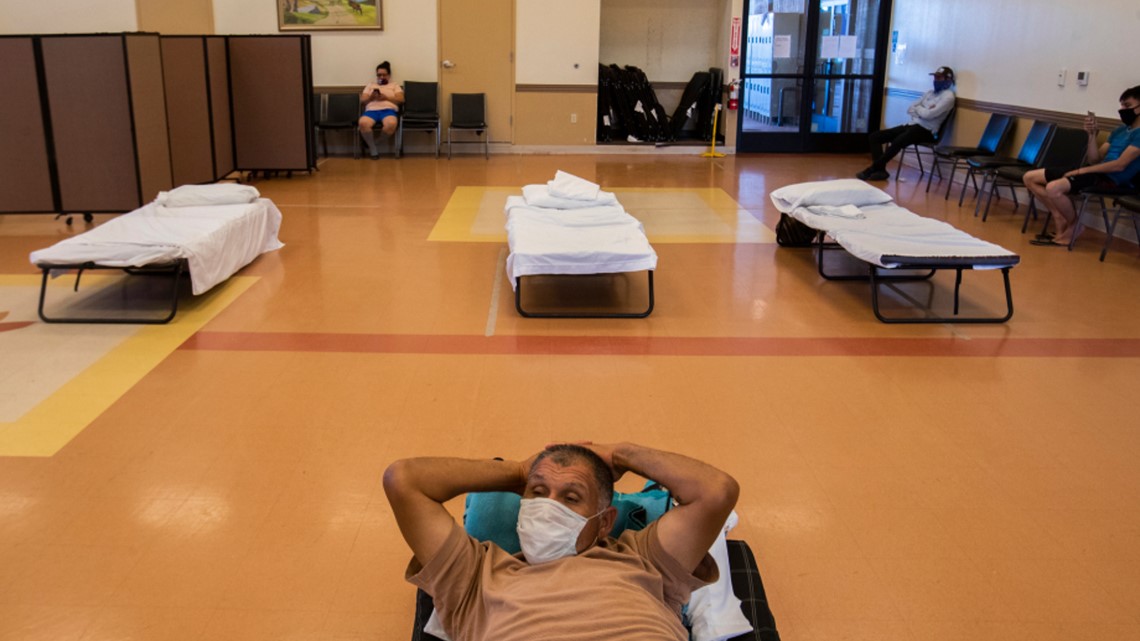SACRAMENTO, Calif — Until the pandemic struck, every day for the last 10 years, Isidoro Flores Contreras stood at the edge of the Sand City Costco parking lot, just a few feet from a set of McDonald’s arches, selling $15 flower bouquets.
No matter the weather, he slowly walked back and forth along the sidewalk, a hitch in his gait as he waved bouquets at cars. More flowers sprouted from large white buckets behind him, tilted like umbrellas on an overflowing beach.
Flores Contreras, who takes home about $300 per week, shut down his business for 15 days when Monterey County issued its stay-at-home order, and he returned when regulations permitted in early May. Back on his corner, although he wears a black cloth mask printed with the LA Kings logo, Flores Contreras is now much more vulnerable to the virus, exposed to dozens of people every day at work and home.
Across California, essential and service workers like Flores Contreras are being hit hardest by the coronavirus, and so are the people they live with. He lives in the most crowded ZIP code in Monterey County, sleeping in the living room of a jam-packed, two-bedroom house he shares with four other people.
Flores Contreras’ housing conditions put him at high risk: The poorest ZIP codes with the most people living in crowded housing are suffering the most from the coronavirus, according to an analysis of housing and health data by The California Divide, a statewide media collaboration. The millions of Californians who live in overcrowded houses are more likely to be infected.
The hardest-hit neighborhoods had three times the rate of overcrowded homes and twice the rate of poverty as the neighborhoods that have largely escaped the virus, according to the analysis. And the neighborhoods with the most infections are disproportionately populated by people of color.
About 6.3 million Californians, or 16%, live in overcrowded housing. A third of those are severely overcrowded. California has the second-highest rate of crowded households in the nation, more than double the nationwide rate.
Around two-thirds of the people who live in these homes — about 4 million people — are essential workers or live with at least one essential worker.
READ MORE:
Health experts say this creates a perfect storm for the coronavirus: People bunched together at night and on the frontlines during the day, exposed to a lot of people both at work and at home.
“Some people are affected more and it does reflect how unequal our society is,” said Justin Feldman, a social epidemiologist at the NYU School of Medicine Department of Population Health.
Hot spots for overcrowded homes are spread throughout urban and rural California, including the Salinas Valley, South Los Angeles, Oakland and desert towns near the U.S.-Mexico border.
Monterey County, home to many farmworkers, leads the state with one in every seven households crowded. In Monterey and San Benito counties, nearly one in 10 households, the highest rate in the state, are both overcrowded and include an essential worker.
The Alisal, a neighborhood in Salinas, is filled with farmworkers and service workers, like Flores Contreras, who live doubled or tripled up so they can afford to pay rent. During a pandemic, though, this can be deadly.
At night, Flores Contreras beds down in the living room of a two-bedroom house in the Alisal, a Mexican and Mexican American community where 61,000 people are squeezed onto a parcel of land less than three square miles annexed by Salinas in 1963.
Tens of thousands of the Alisal’s residents are farmworkers, considered essential workers during stay-at-home orders. The median household income in the Alisal is $49,659 and 22% live in poverty, according to Census data.
Farmworkers are greatly overrepresented among those diagnosed with COVID-19. In Monterey County, the Alisal is the center of the coronavirus outbreak. About a third of the patients in Monterey County live in the 93905 ZIP code, where Flores Contreras resides, even though just 14% of the county’s population lives there.
Their congested living conditions heighten their risk of transmitting the virus to each other.
Read about the housing crisis among California farmworkers.
Flores Contreras pays $300 a month in rent — equivalent to a week of his earnings. Two couples rent the bedrooms. There’s no way they could isolate themselves at home if someone caught the virus, Flores Contreras said.


The Census Bureau defines overcrowding as a home with more people than rooms, while a home with more than 1.5 people per room is severely crowded.
The reason for so many overcrowded houses and apartments? The sky-high cost of housing. Nearly a third of California’s renter households spend more than half their income on rent.
In Monterey County, the link between crowded housing and COVID-19 is clear, revealing big disparities: Its five areas most heavily burdened by the virus had more than twice as much crowded housing as areas with the least people diagnosed, as of June 8.
In Salinas, nestled between two mountain ranges and rooted in fertile produce fields, about one out of every five homes is crowded. Even worse, narrowed to the 93905 ZIP code, where the Alisal lies, nearly a third are crowded, and an average of 4.5 people live in each household.
Drive 22 miles west, and you’ll arrive in Carmel-by-the-Sea, a wealthy live-oaked, cobblestone-paved hamlet of fewer than 4,000 people on the edge of the Pacific. The streets are narrow, the houses are worth millions of dollars and many are walled off from view.
Here, just under 4% of homes are crowded, a stark contrast to the numbers squeezed into the Alisal. Fewer than five people (the county’s reporting cutoff) have been diagnosed with COVID-19 in Carmel-by-the-Sea, compared with 233 in the Alisal’s ZIP code as of June 9, according to the Monterey County Public Health Department.
Models created at the Children’s Hospital of Philadelphia and the University of Pennsylvania provide evidence that overcrowding and population density are the two most important factors driving the spread of the virus.
“Measured against a number of local factors, we saw that strict social distancing policies and low population density. . . were all important in slowing the spread of this dangerous virus,” said Dr. Gregory Tasian, faculty member at PolicyLab and an assistant professor of epidemiology who worked on the models.
In New York City, the coronavirus’s toll has been severe in overcrowded neighborhoods. An analysis found the city’s crowded neighborhoods had bigger jumps in flu-like emergency room visits this March compared with previous years than less-crowded neighborhoods.
Feldman, the NYU social epidemiologist, said even though the data show a correlation, not causation, the result makes sense.
“What we’ve been generally seeing is very high transmission rates within a household. Once one person gets it, it’s very easy to transmit to other people in their household. You can imagine if there’s less space, if people have to share room, it’s going to be really hard to isolate people,” Feldman said.
He also observed that neighborhoods with more foreign-born residents had higher increases in visits for flu-like symptoms in March, as did higher poverty neighborhoods and neighborhoods with more Latino residents. This, too, he said, is grimly logical.
“And who do we know is living in crowded housing?” asked Feldman. “People who are lower income, they’re more likely to be immigrants, more likely to have to go to work.”


Social distancing is especially hard for essential workers, who must leave their homes regularly to keep the rest of the U.S. fed and sheltered. More than 158,000 people over the age of 65 live in a crowded home where at least one member is an essential worker.
More than a third of California’s labor force works in jobs that mean they must be physically present, such as farming, fishing or forestry. And almost a third of farmworkers and restaurant workers live in overcrowded homes. According to an analysis by the Public Policy Institute of California (PPIC), essential workers are more likely than nonessential workers to live in overcrowded housing—16% versus 12%.
“Compared to non-essential workers, they are at higher risk of infection because they continue to circulate among others despite the shutdown,” wrote PPIC researchers Marisol Cuellar Mejia and Paulette Cha.
Overcrowded homes are defined as households with more occupants than rooms of any type, excluding bathrooms.
Crowded housing also puts California’s Latinos at higher risk. Latino households are nearly eight times more crowded than white households. More than three out of every four Monterey County residents who have been diagnosed with COVID-19 are Hispanic or Latino, a much bigger portion than their share of the countywide population (59%), according to the Census Bureau’s American Community Surveys data. About 40% of the people diagnosed in Monterey County work in agriculture.
Oakland is another place with wide disparities in infection rates and housing conditions. In the ZIP code that contains the affluent Montclair neighborhood and Piedmont city, just 1% of homes are overcrowded. Fewer than one in every 1,000 residents tested positive for the coronavirus there. But across town, in the area that encapsulates majority Latino neighborhoods like Fruitvale, the infection rate was six times higher as of late May and 21% of homes are overcrowded.
The same pattern is clear in Fresno County. Mendota has the county’s highest infection rate as of Wednesday and its most overcrowding. On the other end of the spectrum is Clovis, which has a quarter of its poverty rate and many more white residents. Clovis has the lowest rate of crowded homes and the lowest burden of disease.
At the low-income health clinic where Dr. Efrain Talamantes works in Los Angeles, most patients arriving with coronavirus symptoms are Latino, low-income and live in crowded housing. Many are house cleaners, construction workers, grocery store workers and caretakers of the elderly.
Talamantes is the medical director of the Institute for Health Equity at AltaMed Health Services, a health clinic with 35 sites throughout Los Angeles and Orange counties that serves more than 300,000 people.
He said he prefers not to tell his patients who live with a lot of other people to isolate themselves.
“Patients who live in places where there’s no privacy… when you tell someone to get in a room and stay away from their loved ones, it’s almost nonsense to them,” said Talamantes.
The doctor recounted the story of a grocery store worker with concerning symptoms. He told her she had to stay home, and asked if it was possible for her to isolate from her partner and three-year-old child, who loves to climb all over her.
The answer was no.
In their small apartment, there was nowhere to isolate. She had no family who could take her in and no money to rent a hotel room.
In cases like that, Talamantes tries to emphasize hand hygiene and wearing a mask.
Patients are often just as worried about staying housed as they are about the virus, and they fear eviction if their landlord finds out they’ve contracted COVID-19. He frequently finds himself pairing medical advice with information about renters’ rights, including the statewide moratorium on evictions for people affected by the virus.
“What we’re most concerned about is how this virus is going to exacerbate inequalities in communities where we’ve made so much progress since the last recession. It really takes a toll on the communities they’re in,” Talamantes said.
In some neighborhoods of Los Angeles, as many as two in every five households are overcrowded. The areas most heavily burdened by COVID-19 had twice the rate of crowded housing as the areas least hard hit in late May.
Read about how California’s housing crisis sickens families.


Ricardo Hernandez and his family of five live in West Adams, a neighborhood in South Los Angeles where most residents are Latino or black, in a two-bedroom, one-bathroom home that his parents purchased years ago.
In West Adams, about 17% of households are overcrowded, and there were about seven coronavirus cases for every 1,000 residents in late May, almost three times the statewide rate of 2.6 per 1,000.
For months, Hernandez, his wife and two sons shared one bedroom, while his mother, a diabetic, and his brother, a kidney transplant survivor, shared the other. Because of their health problems, they are both highly vulnerable to severe effects if they are infected with the virus.
“We remove our shoes before entering the house, we disinfect door knobs often and we wash our hands as much as we can,” said Hernandez.
Only Hernandez was working, but during the stay-at-home orders, his earnings as a marketing manager were “enough to pay our bills, credit cards, groceries and other basic necessities.”
Should one of them get the coronavirus, the family plans to isolate the infected person in one of the bedrooms, and disinfect the bathroom every time it is used.
Although it was hard, Hernandez said it had been beneficial to stay at home together during the pandemic.
“I feel this is a mental, moral cure and a peace of mind, because we know how we are doing when we see each other,” he said.
For California’s farmworkers, crowded housing is the norm, whether it’s a rental unit, a farmworker shelter, or employer-provided barracks-style housing.
On the northern edge of the Salton Sea in Riverside County, Gloria Gomez runs the Galilee Center, a boarding house for farmworkers who stay in Mecca for just months at a time, a pit stop on their journey around the state to pick fresh produce year-round.
“‘La corrida,’ they call it,” said Gomez. (In English, “the circuit.”)
Gomez, who worked as a farmworker as a child, started Galilee Center 10 years ago because farm workers were sleeping in cars or in parks.
The pandemic, however, has completely changed their operations.
The center expanded its hours to 24 hours a day, provides three full meals a day instead of two and stopped charging farmworkers the usual $7 a day for room and board. Staff moved the beds six feet apart, reduced the number of residents and cleans the dorms every two hours to prevent the spread of the virus.
“I said to (the farmworkers) ‘We’re here to save your lives,’” said Gomez. “‘Please save our lives by staying in our place when you are not working,.’”
Applicants for financial assistance there have exploded. The center is spending $20,000 a month when it used to spend $2,000. And nearly 700 families showed up to the food bank, more than three times the number before January. Galilee Center is struggling trying to find enough donations,
Gomez said many of the farmworkers have caught the coronavirus from another relative in the home, unable to properly quarantine themselves in too-small housing. In recent weeks, Mecca had three farmworkers die from COVID-19, according to the Desert Sun.


Enrique Reyes, a farmworker in Mecca, has one of the coveted 34 farmworker beds at Galilee Center, all grouped together in one large dormitory.
Before the pandemic began, he fought with his wife and moved out of the two-bedroom Salton City trailer they share with their two kids and two grandchildren. But now, he said, he doesn’t want to move back for fear of bringing the virus into their home.
Reyes was living in a storage unit in Mecca, but it got very hot. The temperature can reach past 100 degrees as early as April.
As a farmworker, he cannot afford to lose a day’s work, and the nation cannot afford a food shortage, he said.
At work, Reyes tries to protect himself with social distancing, handwashing and face masks, but he knows he runs a risk of catching the virus. He saw his decision to stay away from his family as a way to keep them safe.
“Nada es cien por ciento,” said Reyes. “¿Qué más puedo hacer? No me puedo ir a la luna ni llevar mi familia a la luna. Tengo que seguir las reglas como todas las personas.”
In English, “Nothing is certain, but what else can I do? I can’t fly to the moon or take my family to the moon with me. I have to just follow the rules like everybody else.”
Kate Cimini of The Californian reported this story with support from the California Fellowship through the USC Annenberg Center for Health Journalism.
J. Omar Ornelas of the Desert Sun, Jacqueline Garcia of La Opinión and Matt Levin of CalMatters contributed to this story.
This article is part of the California Divide project, a collaboration among newsrooms examining income inequality and economic survival in California.

